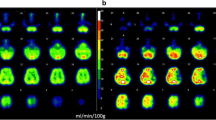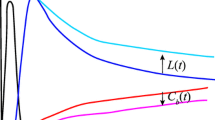Abstract
Technetium 99md,l-cyclobutylpropylene amine oxime (99mTc-CBPAO) has been developed as a brain-imaging agent for single photon emission tomography (SPET).99mTc-CBPAO can be prepared using a simple labelling procedure suitable for routine clinical use. It has a high in vitro stability, as has been demonstrated by high-pressure liquid chromatography (HPLC) analysis. This shows that 3 h after labelling, less than 5% of the primary lipophilic complex which is capable of crossing the blood-brain barrier (BBB) converts to a secondary hydrophilic complex. Brain uptake (% dose/g wet tissue) of99mTc-CBPAO, determined at 5 and 30 min after injection in two groups of six adult male Sprague-Dawley rats, was found to be 0.74±0.06 and 0.73±0.13 (mean ± SD), respectively. These values are not significantly different from those obtained repeating the experiment with99mTc-labelled hexamethylpropylene amine oxime (99mTc-HMPAO) (0.72±0.15 at 5 min and 0.88 ± 0.24 at 30 min after injection). Since the rat brain uptake of99mTc-CBPAO remained unchanged for a period of time suitable for tomographic study, the comparison of the two tracers was extended to two groups of ten patients. The latter were affected by neurological and psychiatric disorders and were studied with SPET. Human brain uptake (% dose/cc cortical grey matter) of99mTc-CBPAO and99mTc-HMPAO were 3.04±0.57 and 4.22±0.46 (mean × 10−3 ± SD × 10−3), respectively, with a 32% significant difference. In two other groups of five patients, the first transit time-activity curves of the two tracers were compared. From the analysis of these curves we suggest that99mTc-CBPAO has a higher binding effect on blood components and/or a higher degradation rate in blood than that of99mTc-HMPAO. This may account for the reduced human brain uptake. In conclusion, SPET images of99mTc-CBPAO reflect blood perfusion, and they have a good diagnostic quality. The main advantage of99mTc-CBPAO is its in vitro stability; however,99mTc-HMPAO is a superior imaging agent.
Similar content being viewed by others
References
Andersen AR (1989)99mTc-d,l-hexamethylene-propyleneamineox-ime (99mTc-HMPAO): basic kinetic studies of a tracer of cerebral blood flow. Cerebrovasc Brain Metab Rev 1:288–318
Cavazzuti M, Porro CA, Biral GP, Benassi C, Barbieri GC (1987) Ketamine effects on local cerebral blood flow and metabolism in the rat. J Cereb Blood Flow Metab 7:806–811
Chaplin SB, Oberle PA, McKenzie EH, Hoffman TJ, Volkert WA, Holmes RA, Canning LR, Pickett RD, Nowotnik DP, Neirinckx RD (1986) Regional cerebral uptake and retention of99mTc-tetramethyl and pentamethyl propyleneamine oxime chelates. Nucl Med Biol 13:261–267
Colombo F, Lunghi, Deleide G, Matarrese M, Bonino C, Jang Libson K, Belletire J, Fazio F, Deutsch E (1989) A new99mTc PAO cerebral perfusion agent with in vitro stability. J Nucl Med 30:742 (abstract)
Formiconi AR, Pupi A, Passeri A (1989a) Compensation of spatial system response in SPELT with conjugate gradient reconstruction technique. Phys Med Biol 34:69–84
Formiconi AR, Pupi A, De Cristofaro MT, Dal Pozzo G, Fargnoli R, Meldolesi U (1989b) Superimposition of brain sections from different acquisition techniques (CT and SPELT). J Cereb Blood Flow Metab 9 (Suppl 1):S413
Friston KJ, Passingham RE, Nutt JG, Heather JD, Sawle GV, Frackowiak RSJ (1989) Localization of PET images: direct fitting of the intercommissural (AC-PC) line. J Cereb Blood Flow Metab 9:690–695
Holmes RA (1986) A reawakening of interest in radionuclide brain imaging. J Nucl Med 27:299–301
Hung JC, Corlija M, Volkert WA, Holmes RA (1988a) Kinetic analysis of technetium-99m-d,l-HM-PAO decomposition in aqueous media. J Nucl Med 29:1568–1576
Hung JC, Holmes RA, Volkert WA (1988b) In vivo performance of Tc99m-d-l-HMPAO using gentisic acid. J Nucl Med 29:981 (abstract)
Hung JC, Volkert WA, Holmes RA (1988c) Stabilization of Tc99m-d,l-HMPAO using gentisic acid. J Nucl Med 29:935(abstract)
Lassen NA, Blasberg RG (1988) Technetium-99m-d,l-HM-PAO, the development of a new class of99mTc-labeled tracers: an overview. J Cereb Blood Flow Metab 8: S1-S3
Lassen NA, Andersen AR, Friberg L, Paulson OB (1988) The retention of [99mTc]-d,l-HM-PAO in human brain after intracarotid bolus injection: a kinetic analysis. J Cereb Blood Flow Metab 8: S13-S22
Levin VA (1980) Relationship of octanol/water partition coefficient and molecular weight to rat brain capillary permeability. J Med Chem 23:683–684
Messa C, Zito F, Rossetti C, Colombo F, Matarrese M, Taddei G, Deutsch E, Lucignani G, Fazio F (1989) Evaluation of a new tracer for cerebral perfusion studies: Tc-99md,1-CB-PAO. Preliminary results in humans. J Nucl Med 30:426 (abstract)
Nakamura K, Tukatani Y, Kubo A, Hashimoto S, Terayama Y, Amano T, Goto F (1989) The behavior of99mTc-hexamethyl-propyleneamineoxime (99mTc-HMPAO) in blood and brain. Eur J Nucl Med 15:100–107
Neirinckx RD, Canning LR, Piper IM, Nowotnik DP, Pickett RD, Holmes RA, Volkert WA, Forster AM, Weisner PS, Marriott JA, Chaplin SB (1987) Technetium-99md,l-HM-PAO: a new radiopharmaceutical for SPELT imaging of regional cerebral blood perfusion. J Nucl Med 28:191–202
Neirinckx RD, Burke JF, Harrison RC, Forster AM, Andersen AR, Lassen NA (1988) The retention mechanism of technetium99m-HM-PAO: intracellular retention with glutathione. J Cereb Blood Flow Metab 8: S4-S12
Pupi A, De Cristofaro MTR, Formiconi AR, Passeri A, Speranzi A, Giraudo E, Meldolesi U (1990) A PET-SPET brain phantom with variable inner contrast. Eur J Nucl Med (in press)
Sachs L (1982) Applied statistics. A handbook of techniques. Springer-Verlag, Berlin Heidelberg New York, p 214
Sapirstein LA, Hanusek GE (1958) Cerebral blood flow in the rat. Am J Physiol 193(2):272–274
Scheffel U, Goldfarb HW, Lever SZ, Gungon RL, Burns HD, Wagner HN (1988) Comparison of technetium-99m aminoalkyl diaminodithiol (DADT) analogs as potential brain blood flow imaging agents. J Nucl Med 29:73–82
Tokunaga A, Takase M, Onani K (1977) The glabella-inion line as a baseline for CT scanning of the brain. Neuroradiology 14:67–71
Troutner DE, Volkert WA, Hoffman TJ, Holmes TJ, Holmes RA (1983) A tetradentate amine complex of Tc-99m. J Nucl Med 24:10
Troutner DE, Volkert WA, Hoffman TJ, Holmes RA (1984) A neutral lipophilic complex of99mTc with a multidentate amine oxime. Int J Appl Radiat Isot 35:467–470
Author information
Authors and Affiliations
Rights and permissions
About this article
Cite this article
Bacciottini, L., Lunghi, F., Pupi, A. et al. Evaluation of technetium 99m cyclobutylpropylene amine oxime as a potential brain perfusion imaging agent for SPET. Eur J Nucl Med 17, 242–247 (1990). https://doi.org/10.1007/BF00812364
Received:
Revised:
Issue Date:
DOI: https://doi.org/10.1007/BF00812364




